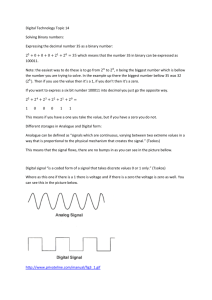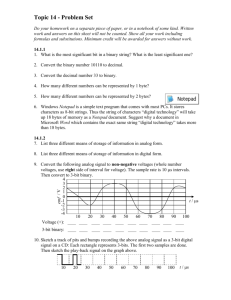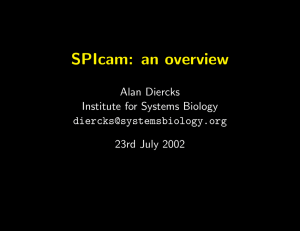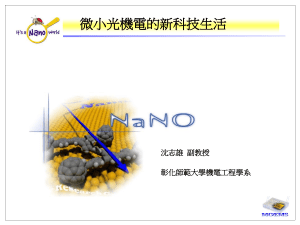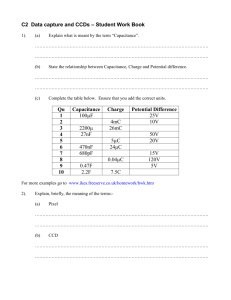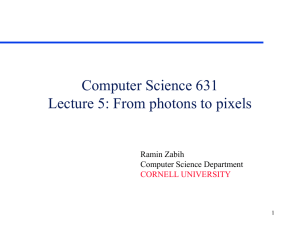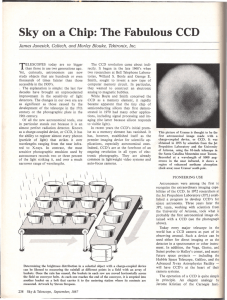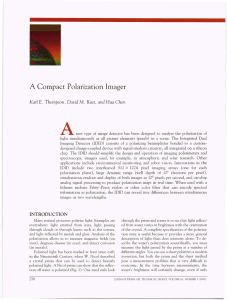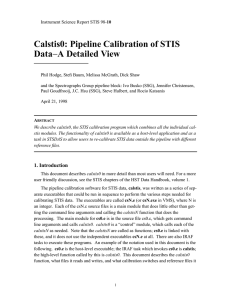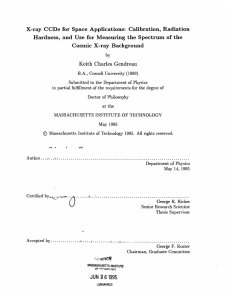Charged Coupled Device
advertisement
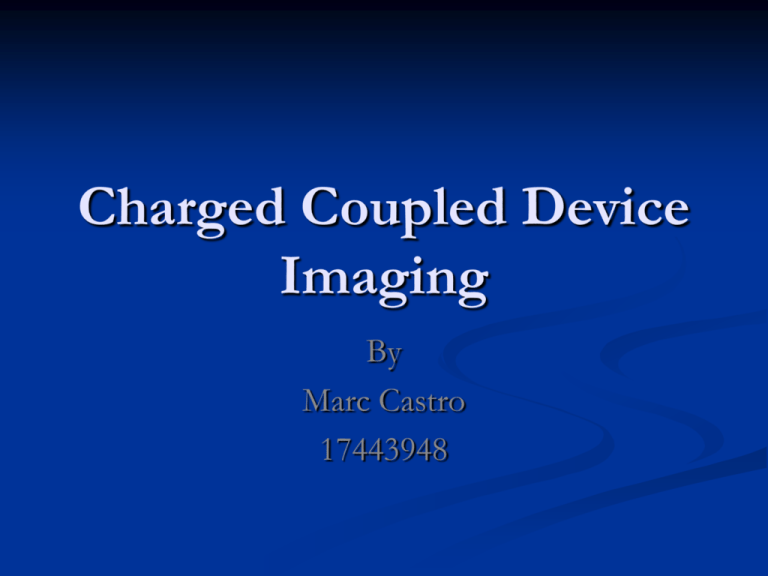
Charged Coupled Device Imaging By Marc Castro 17443948 CCD Imaging Process (3 step process) 1. Exposure Converts light into an electronic charge at discrete sites called pixels, photo sites, photodiodes or capacitors. 2. Charge Transfer One of the CCD architectures is used. 3. Charge to voltage Signal conversion from analog (electrical charges) to digital (0’s and 1’s). How does it look like? Charged Couple Device What is it? Charged Coupled Device (CCD) an analog shift register, that enables the transportation of analog signals (electric charges) through successive stages (pixels) controlled by a clock signal. Primary uses: Memory Delaying samples of analog signals In an array of photoelectric light sensors (image sensors) History Invented in 1969 Creators: Willard Boyle and George E. Smith Location: AT&T Bell Labs. Currently part of Lucent Technologies Motivation: the lab was working on the picture phone and on the development of the semiconductor bubble memory. CCD – originally designed as an electronic memory device that can be charged by light. CCD Fabrication Made using photolithography techniques. Individual pixel gate fabricated on a silicon wafer Courtesy of Olympus End Product Don Groom LBNL Capturing Images The CCD - comprised of many individual signal capture units (photo sites, capacitors, pixels) CDD - 2D Pixel Array Capturing Images How charges are stored •CCDs are comprised of pixels (capacitors) which are MOS (Metal Oxide Semiconductors). •MOS allow electron charges to build up within the wells. Capturing Images •Light – incoming photons falls onto the surface of a pixel. (CDD - 2D array of pixel elements) •Result- generates free electrons in the silicon of the CCD due to the photoelectric effect, proportional to the number of photons striking it. These electrons collect in little packets. •Point- the total charge is proportional to the light intensity at that pixel. A brighter image ( higher electrical charge). A darker image ( lower electrical charge). •Drawback- only measures intensity. Not color!!! •CCD’s normally have 1 to 5 million packets of charge. CCD Scanning Formats CCDs can be used to collect an image in one of three ways, either one pixel at a time, one row at a time, or as an entire area at once. Methods to capture color Method 1: Beam Splitter Method 2: Bayer Pattern Courtesy of HowStuffWorks 2-D Pixel Array with Bayer Pattern Used over the CCD (color grid over imaging array) Each square (4 pixels) contains One red One blue Two green Transfer image from array. General Idea – Control circuit causes each pixel to transfer its contents to its neighbor using a clocking scheme. The last pixel in the array dumps its charge into a charge amplifier, which converts the charge into a voltage. The controlling circuit converts the entire semiconductor contents of the array to a sequence of voltages, which it samples, digitizes and stores in some form of memory. Readout Architecture Full Frame Frame Transfer Interline They are the most common Full Frame Architecture Courtesy of Molecular Expressions Frame Transfer Architecture Courtesy of Molecular Expressions Interline Architecture Courtesy of Molecular Expressions Storing the image Analog to digital converter Samples the analog signal and turns the information into bytes of (1’s and 0’s). Charge amplifier – converts the charge into voltage. Record bytes in a storage medium Memory Cards Hard Drive DVD Applications Digital Photography Astronomy Sensors Electron Microscopy Medical Fluoroscopy Optical and UV Spectroscopy Devices Astronomical Telescopes Scanners Bar code readers Machine vision for robots. Optical character recognition (OCR) Works Cited Tom Harris. “How Camcorders Work.” HowStuffWorks.http://electronics.howstuffworks.com/camcorder.html “Charge-coupled device.” Wikipedia. http://en.wikipedia.org/wiki/Chargecoupled_device “Building A Charge-Coupled Device.” Olympus Microscopy Resource Center. http://www.olympusmicro.com/primer/java/photomicrography/ccd Tom Thompson. “Charge-Coupled Device.” ComputerWorld. http://www.computerworld.com/softwaretopics/software/multimedia “What is a Charge-Coupled Device.” Tech-Faq. http://www.tech-faq.com/chargecoupled-deivce.shtml Lucent Technologies. “CCD-The History of CCDs or Charge Coupled Devices.” About.com Inventors. http://inventors.about.com/od/cstartinventions/a/CCD.html “Charge-Coupled Device (CCD) sensor.” MIR. http://www/mir/com.my/rb/photography/digitalimaging/ccd/html “Charge-coupled deivce.” Whatis.com. http://searchstorage.techtarget.com/sDefinition/0,,sid5_gci295633 Works Cited “Anatomy of a Charge-Coupled Device.” Molecular Expressions Optical Microscopy Primer: Digital Imaging in Optical Microscopy. http://micro.magnet.fsu.edu/primer/digitalimaging/concepts Eric Meisenzahl. “Charge-Coupled Device Image Sensors.” Eastman Kodak Co. http://engage.advanstar.com/jnserver/acc_random “Charge-couple device.” Answers.com. http://www.answers.com/topic/chargecoupled-device
